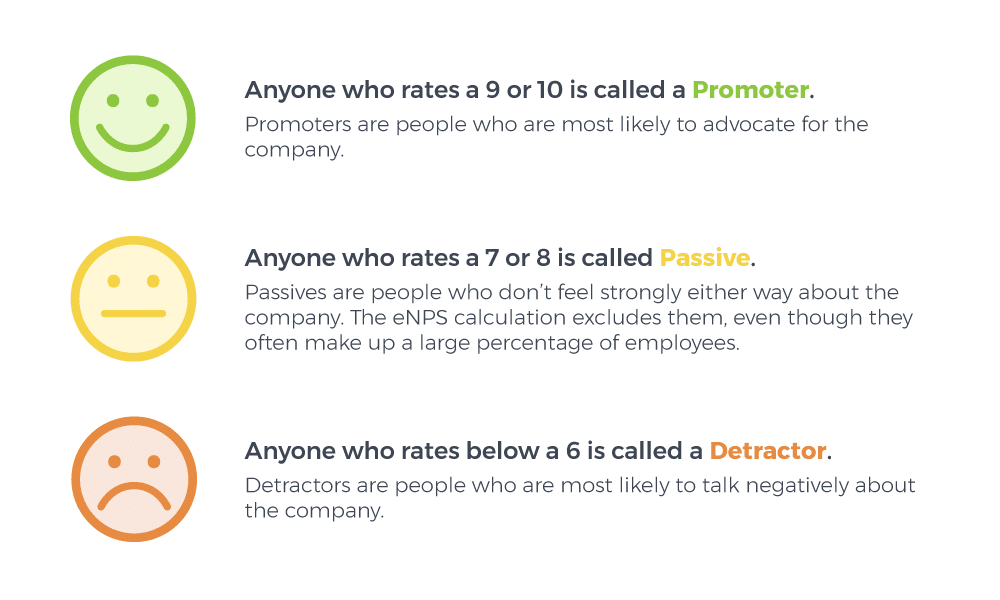
What is employee satisfaction?
Employee satisfaction describes how content and happy employees are with all aspects of their job. There are several factors that can contribute to employee satisfaction within the workplace, including: employee experience, opportunity for career growth, job flexibility, relationship with colleagues, and work-life balance.
Not only does employee satisfaction have a significant impact on the levels of employee engagement, but it also has a direct correlation to the overall productivity of your business.
Simply put, satisfied employees generate a higher business output than unsatisfied employees.

How to monitor employee satisfaction levels
Having a solid understanding of employee satisfaction levels can often be the difference between high productivity and a resignation. There are a slew of tools at your disposal that can help you track employee satisfaction levels within your organization.
One such tool is an Employee Net Promoter Score (eNPS) survey. An eNPS survey is an internal scoring system that helps business leaders assess the levels of employee loyalty and engagement. The result of the survey dictates whether an employee is placed into one of three different categories based on their feedback: promoters, passives, and detractors.

eNPS surveys allow managers to get a finger on the pulse of their teams and effectively engage employee morale. In addition, by conducting these surveys you are showing your employees that you value their input.
5 ways to improve employee satisfaction
#1: Recognize the efforts of your employees
Employees thrive on positive feedback. Unfortunately, it can be quite difficult for leaders to find a consistent way to highlight individual/team accomplishments without a process in place. When your employees are performing at a high-level, cast a spotlight on them and recognize their work. When leadership praises the efforts of a team or individual employee, it can go a long way in making the employees feel valued and appreciated by the company.
An effective employee recognition program can help improve your company culture, boost morale, and create a space for employees to recognize each other’s work and personal milestones.

#2: Provide effective business tools
Another way to improve employee satisfaction is to equip your employees with the tools and resources they need to do their job effectively. Nothing leads to dissatisfied employees like inefficient platforms and unclear processes.
It is crucial to provide your employees with the internal communication and work collaboration tools that can allow them to conveniently access what they need, when they need it. This will lead to higher productivity and remove any frustrations that can arise when dealing with slow and outdated systems.
#3: Encourage social connections
Create opportunities for your employees to connect with colleagues in other office locations or departments. Not only does this naturally create ‘happier’ employees, it also can help make the company feel smaller.
One way to encourage this is by having an internal employee directory available to your workforce. With an employee directory, employees can easily search for colleagues that might have shared work responsibilities, shared interests, or skills that could provide value on a specific project. As a result, this will help build better office relationships and more efficient teams.

#4: Offer employee growth opportunities
Keep employees satisfied by offering a wide slate of employee growth opportunities. Give your employees a chance to learn new skills, develop professionally, and participate in learning courses/programs. Employees that are stagnant with their responsibilities and have limited opportunity for career advancement are likely to become dissatisfied with their job.
Investing in employee growth can grow the skill level of your workforce, ultimately benefitting the company’s bottom line. In addition, you will be able to fulfill more roles internally as more of your staff become qualified for certain positions. When employees feel that they have room to grow within the organization, they are much more likely to want to stay.

#5: Embrace remote & hybrid work
The pandemic has revealed that organizations can support remote work environments. More importantly though, it has shown employees that they can still effectively do their work while away from the office. While remote work was once thought of as a luxury, it is now considered a necessity for employees. A survey of the U.S. workforce revealed that over 68% of Americans would prefer to work remotely in some capacity.
By offering flexible work environments and allowing employees to work remote, you can improve employee satisfaction levels throughout the organization. Data also suggests that offering remote work environments can improve the productivity of your workforce. Over 40% of remote employees believe that they are more productive while working at home during the pandemic, as opposed to the office.
This indicates that hybrid/remote work environments don’t just improve employee satisfaction, but they also contribute to higher productivity levels and ultimately, a higher business output for the organization.
How to get started
Improving employee satisfaction can do wonders to employee morale as well as your company’s bottom line. So how do you get started?
We recommend considering a modern intranet platform. An intranet platform (like MangoApps) offers you a place to centralize content, connect with colleagues, measure employee feedback, and much more. It truly is the holy grail of improving employee satisfaction and engagement! To help decide what platform is the best fit for you, schedule a call for your own personalized demo.
For further reading, check out this blog that details 7 top intranet features your employees will love.







